Abstract
One of the main current problems in European quality agricultural production is the lack of objective data for linking quality to origin and to evidence environmental concern (CO2 uptake and use of water in Spain). The aim of this study was to develop an agricultural management platform, based on Enterprise Resource Planning (ERP) principles and with the ability to collect geolocated information from different plots related to Protected Designation of Origin (PDO) and Protected Geographical Indication (PGI) wine production. First a survey to farmers, technicians and PDO and PGI managers was carried out to detect the needs of the three groups in relation to ERP platforms; and secondly an ERP platform was developed to collect agronomic information to comply with the Spanish legal requirements. Results showed that the end user completes information database, complies with the legal requirements, and obtains benefits derived from the data analysis. Consequently, the platform (i) solves lack of agricultural data problem; (ii) provides the user with management tools for its agricultural operations; (iii) allows the decision maker to obtain geolocated information in real time; and (iv) sets out the bases for the future development of agricultural systems based on Big Data.
Keywords:
ERP; GIS; internet of things; precision agriculture; quality; environment; water; software; platform; web application 1. Introduction
European agriculture faces two mayor challenges, quality linked to origin and production systems that must reduce impacts to environment. Both need real and continuous data to show their evidences to society. Currently, to achieve this, a change in the agricultural paradigm is necessary through the incorporation of four new technologies: Big Data, Precision Agriculture, Industry 4.0., and Enterprise Resource Planning (ERP). This is specially required in the case of food quality productions linked to origin such as Protected Geographical Indications (PGI) and Protected Designations of Origin (PDO).
The potential of regional products differentiated for their quality has been recognized by the introduction of legislation governing PGI and PDO. These certifications are intended to facilitate the consumer’s recognition of the product and perception of superior quality [1,2]. In addition, this has contributed to quality labelling becoming a source of competitive advantage [2]. Felzensztein [3] analyzed the effect of the country or region of origin of agricultural production as an important source of competitive advantage. They reported that for farm products with a long tradition, such as wine, the region of origin (considered as a more specific area than the country of origin) can provide major market positioning opportunities of creating a sustainable competitive advantage.
Protecting PDO and PGI references is a key aspect of the European Common Agricultural Policy (CAP). A good example is the case of the Tocai/Friulano grape variety traditionally grown in Italy, which came into dispute with the Hungarian wine Tokaji, arguing that Italian wines took advantage of the Tokay Designation of Origin since they sounded similar, and finally the European Union prohibited Italian wines from using the brand [4,5].
In this sense, the name of an area, that is strongly associated with a given product quality, is associated to high quality products even though it might not be, and in many cases these associations drive the consumer’s purchasing decision [6]. Terroir underpins the process of demarcation so that the concept fits neatly here and relates to both environmental and cultural factors that together influence the complete production process (in this case, form the grape growing to wine production continuum). The physical factors that influence the process include matching a given agricultural product to its ideal climate along with optimum site characteristics of elevation, slope, aspect, and soil [7].
The quality of an agricultural product is linked to PDO or PGI scheme, however, is the result of the combination of five main factors: the climate, the site or local topography, the nature of the geology and soil, the choice of the variety, and how they are together managed to produce the best crop [7]. To develop a system that collects data from the plot, ensures origin and allows continuous improvement of quality is a driving force for quality agriculture. This is especially relevant in the case of PDO and PGI as they face, at least, three decision levels: farmers, processing companies and PDO and PGI managers.
Furthermore, CAP has three clear environmental goals, each of which are listed in the European Green Deal and Farm to Fork strategy: tackling climate change, protecting natural resources, and enhancing biodiversity. Farmers must be aware about the need to provide evidences that they are ensuring the best practices to get CAP environmental goals. The use of water is a key concern in the case of Spanish agriculture.
All represent a technological challenge for agriculture, but together they can be the definitive tools to achieve optimal and sustainable quality agricultural management. In this sense, Big Data allows interpretation and analysis of the constant flow of information provided by Precision Agriculture through the interactivity between devices given by Industry 4.0., and finally, ERP will manage all this. Big Data is often described as a new frontier within the world of new technologies, providing companies with a competitive advantage [8].
The concept of this new paradigm is based on the management and storage of large amounts of data, which are then analyzed in search of patterns or models and is based on five basic principles [9]: volume, variety, velocity, value, and veracity. The required information for Big Data to be able to improve agricultural management may come from various sources, mainly based on Precision Agriculture. These provide a high and constant flow of information, whose management will be one of the main challenges to overcome. This new situation is going to suppose a revolution in the way in which information is stored and administered and will be able to provide a source of innovation and of added economic value [10]. Big Data faces a similar situation to that which arose at the beginning of the current decade, when it was debated whether cloud computing was an appropriate or necessary strategy and how it should be integrated into companies [11]. The technological challenges related to Big Data will result in the following issues that must be solved by each organization:
- The storage infrastructure. This can reveal the limitations of the company’s technical capabilities and requires major changes at different levels of the organization [12].
- The technology to integrate the information into the system. At this point, development of an Application Programming Interface (API) is essential, allowing Internet of Things (IoT) components to communicate and exchange information with the database in a safe way [13].
- The diversity of the formats according to the source. Data collection from such different sources and their translation into useful and structured information are two of the big challenges that Big Data faces [14].
- The calibration system, source verification and data security.
- The speed of data processing. Traditional Relational Database Management Systems (RDBMS) have been the systems mainly used since 1970 [15]. They show great efficiency and integrity in data management; but they are not designed to be systems distributed or balanced depending on the load. This is where NoSQL or non-relational systems can show their full potential, offering functionalities in data analysis that are impossible for traditional RDBMS systems [16]. In this sense, one of the main solutions that companies are adopting is the use of a hybrid data storage system, where the best properties of each of the systems are exploited [17].
Agriculture is an activity traditionally subject to instability and inaccuracy since it depends on biological and climatic factors that add uncertainty to the system. A way to alleviate these problems is incorporating the variability of agricultural activity into the decision-making process by increasing the information points and the flow of data. One of the main tools to do this is Precision Agriculture, which gives the possibility of managing the decision-making on the farm to identify, quantify, and respond to the variability [18].
Therefore, the problem that arises is to establish data flows linked to the farm plot and several tools are available for this:
- Geographic Information System (GIS) which provides information separated into layers. This technological system has been used for decades for territorial and environmental management [19].
- Satellite images. For instance, Normalized Difference Vegetation Index (NDVI) images permit differentiating distinct states of vegetative growth.
- Weather stations at the plot level as climatic variability is an important aspect of uncertainty in agriculture.
- IoT. Allows the development of sensors and automation to obtain plot information in real time.
- External information sources. Access to databases, public or private, that can provide information (climatic, geographic, statistical, economic, etc.).
However, Precision Agriculture cannot provide the most decisive data for model development through Big Data. These data are those obtained from plot management and cover aspects such as water use, pest incidence, fertilizer use, phytosanitary treatments, and costs. These data can only be provided by the farmer. Historically, this information has been collected through field surveys (a slow and expensive process). In addition, many farmers have reservations about sharing their data. In this respect it is worth mentioning that, in October 2014, the American Farm Bureau conducted a survey of a group of farmers and 77.5% of them responded that they were afraid that either the regulators or the government could have access to the data that they were facilitating [20]. This concern, regarding such valuable information, should lead to the implementation of a data collection system that respects farmer privacy.
It is possible to go further through the use of new technologies that allows the setting-up of systems capable of exchanging information among themselves, and even create optimized networks that communicate with each other (via wireless or another system), and finally send the information to the data center where it can be stored and analyzed [21]. This concept of interactivity among devices, creating complex networks that can find solutions to problems, is what is called Industry 4.0 [22]. Industry 4.0 supposes the abolition of traditional separation between the physical world and the virtual world, achieving a fusion of reality and its virtual model [23] using model development that allows the implementation of an effective decision-making system based on objective data. A system based on the concept of agriculture 4.0 should consist of a process based on four phases [24]: data collection, centralization of data, predictive data analysis and visualization of results. Application of Industry 4.0 to agriculture is the next technological advance and is based on a more intelligent and predictive behavior [25], where technology takes a leading role and offers tools for business management in the 21st century.
This implies the need to develop ERP II concept. This term was first used by the Gartner Research Group in 2000, when proposing that software should go beyond the company itself and be open to receive information from customers, suppliers, or business partners [26]. This new approach, together with the use of Cloud-based systems, Information and Communication Technology (ICT), Internet of Services (IoS), IoT, Business to Business (B2B), and Business to Consumer (B2C), will allow the development of a tool that facilitates the decision-making process [27], which will be basic in the future of agriculture and will help to move to Agriculture 4.0. Therefore, automation and the use of new technologies will provide agricultural systems with stability and certainty, which was missing in previous scenarios, and that will allow them to meet the required standards for using ERP systems. As a result, farmers will be able to respond to society requirements for quality food linked to origin and an agriculture that respects the environment providing evidences of their commitment.
In this sense, the objective of this paper was to develop an ERP platform for the management of an agricultural farm, based on Agriculture 4.0., by obtaining agronomic data linked to plots through Precision Agriculture and the management of the data through Big Data, to respond to the needs of the agricultural sector. The ERP platform designed for the farm integral management comply with current legal and administrative requirements, use the new technologies, and develop predictive models based on collected data. This platform was presented for the case of wine production under PDO and PGI schemes.
In Figure 1, interconnections among CAP, PDO/IGP and the coordination of their several aspects through an ERP can be seen.
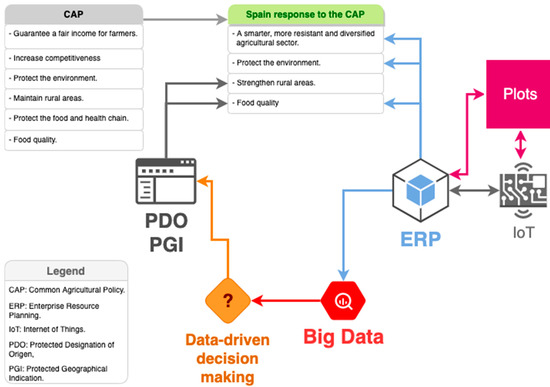
Figure 1.
Interconnections among CAP objectives, PDO/IGP and the coordination of their several aspects through an ERP.
2. Materials and Methods
2.1. Survey of Farmers, Technicians, and Quality Managers under PDO and PGI Schemes
To know if there was a need for this type of platform development, a survey and interviews with farmers, winery technical managers, and quality directors of entities that manage wine linked to origin (PDO and PGI) were conducted. This survey was important to understand the platform viability, their needs, and if there are differences in the perception of the utility of the platform.
In the case of vine farmers, a stratified random sampling was carried out around Spain with an allocation proportional to the number of farmers that commercialize their grape production through PDO and PGI schemes. The sample size was 400, which supposes a sampling error of 5% with a 95.5% confidence level. The information was obtained via personal interview after arranging an appointment by telephone.
The final questionnaire, after two pre-tests, included a first part whose purpose was to classify the respondent according to place of birth, age, years in office, level of studies, etc. In the second part, reference was made to the data of the company or entity: number of partners, volume traded, area, number of employees, etc. Finally, the questionnaire (Table 1) focused on obtaining information directly related to the validation of the proposed platform.

Table 1.
Questionnaire answered by farmers, technicians, and managers.
2.2. Design of an ERP Platform for an Agricultural Holding
Considering the need of ERP system implementation according to farmers, technicians and managers’ survey, an ERP platform has been developed following three basic ideas: (i) the use of Open Source (everybody can use, modify and share software) software whenever possible allowing to reduce production and maintenance cost; (ii) the development of a communication system among devices, which will collect data in real time to the platform throw an API; and (iii) the simplicity of the system to avoid complex interfaces for the final user.
Figure 2 shows the entire research process carried out for the development of the ERP application.
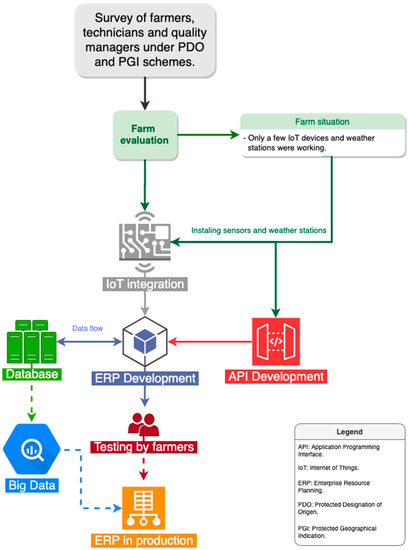
Figure 2.
Flowchart of the different steps of the research methodology.
2.2.1. System Architecture Design
Laravel framework was chosen for the ERP platform development. Laravel is a free, open-source PHP (Hypertext Pre-Processor) web framework, created by Taylor Otwell. Frameworks like Laravel, prepackage a collection of third-party components together with custom configuration files, service providers, prescribed directory structures and application bootstrap [28], and is based on the Model, View, and Controller (MVC) architecture (Figure 3).
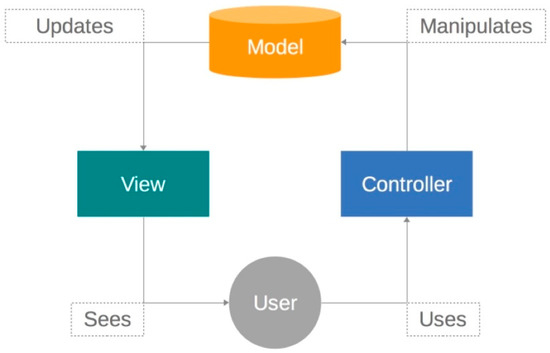
Figure 3.
Collaboration between components in an MVC structure.
This structure is designed to divide the software into three blocks (the model, the view, and the controller) to have better control over final product quality [29]. The framework provides a list of functionalities, out of the box, such us authentication, routing, session manager, caching, IoC (Inversion of Control) container, middleware, Eloquent ORM (Object-Relational Mapping), database migration and seed tools, integrated unit testing support, etc. Laravel 5.6 and PHP 7.1 was used for this project development.
When a client sends a HTTP (HyperText Transfer Protocol,) request, the web server executes this request through the PHP engine, and this is where Laravel executes all the procedures that will lead to a final response [30]. This can be returned through the browser, in HTML5 (HyperText Markup Language, version 5) format, or through the platform API (Application Programming Interface), in JSON (JavaScript Object Notation) format.
The Laravel lifecycle, starts with the request that executes the initial framework file, located at public/index.php which initializes the whole process: loading the Kernel, the Service Providers, configuration files, etc. after that will dispatched the routes, the middleware, the controllers, the models, the views and finally the response is sent to the user’s browser (Figure 4).
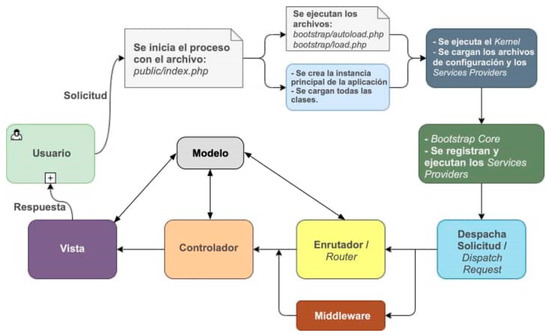
Figure 4.
Laravel lifecycle.
The project uses a list of Laravel packages as are mentioned below (the packages bellow are Open Source):
- anhskohbo/no-captcha: wrapper for Google no-captcha, version 3.0 [31].
- askedio/laravel-soft-cascade: used to manage the deletion of entries in the database from related tables, version 5.6 [32].
- barryvdh/laravel-dompdf: used to generate reports in pdf format, version 0.8.2 [33].
- genealabs/laravel-model-caching: for automatic model caching, version 0.2.62 [34].
- intervention/image: powerful tool for image management, version 2.4 [35].
- grimzy/laravel-mysql-spatial: used to store geolocated data in the database, version 1.0 [36].
- maatwebsite/excel: used to import data from excel files, version 2.1.0 [37].
- spatie/laravel-cookie-consent: a configurable way to display the cookie consent, version 2.2 [38].
- spatie/laravel-html: for advanced HTML management, version 2.19 [39].
- spatie/laravel-permission: for roles and permissions, version 2.1 [40].
Finally, for the management of the administration panel, Laravel Nova [41] (a commercial package for Laravel) has been used, being the only resource that is not Open Source, and which entailed the purchase of a user license. This project uses the default middleware from Laravel, in addition to a series of custom middleware.
However, in some cases it was needed to extend its functionalities, and a series of custom middlewares were created, which are described below:
- The Https middleware, which forces the use of secure routes under a secure server.
- The Locale middleware, which investigates user preferences for his default language and determines this language as preselected.
- The IsAdmin middleware, to identify the system administrator.
2.2.2. Databases and Eloquent ORM
For the management of the databases, a hybrid system using MariaDB (version 5.7.31) and MongoDB (version 4.0) was selected. MariaDB is a database based on MySQL an Open Source project, free, with a fast response, very easy to use, and frequently employed by large companies [42]. MongoDB is a powerful, scalable, and flexible database that stores information in files with a JSON structure [43]. This decision was based on the characteristics of each of the platform’s needs. Relational systems, such as MariaDB, are more effective for the management of multi-column transactions, such as user management or accounting operations, while non-relational systems, such as MongoDB, are more effective when it comes to dealing with data management in real time, such as climate data or data from sensors [44]. The decision on which parts of the data structure will use each system is complex a priori, thus it will be an issue that might be solved with the use of the application. As a starting point, it was decided that the climatic data and data coming from the IoT-based devices would be stored in the non-relational database, while the rest of the information would be stored in the relational database. This decision will be flexible and must adapt to system needs.
Laravel includes by default an ORM (technique for converting data among incompatible type systems using object-oriented programming languages [45]) called Eloquent, based on active records. and which is intuitive and easy to manage. The operation is simple, each table in the database is related to a PHP class, which includes all the logic necessary to interact with the database [46]. This classes are the Model in the MVC pattern and has also support for relational tables, providing specific classes to perform these operations in Models.
2.2.3. API Connection
Regarding data collection from outside the application, an API was used as recommended [47]. API is defined as a secure connection bridge between external data and the platform, allowing the system to send data from external devices. The APIs are being so standardized that the vast majority of companies are playing the same rules, using the Representational State Transfer (REST) model on the Hypertext Transport Protocol Secure (HTTPS) standard, and using actions such as GET, POST, PUT, and DELETE as if they were web browsers [48]. In this case, a REST model was chosen, using it for API development. API operation consists of the source of information (for example, a sensor) which must connect to the Internet Protocol (IP) address (for security reasons, 127.0.0.1 is used) where the platform is located, and will require access control based on the authorization system that includes Laravel by default. Table 2 explains all the parameters supported by the API and the HTTPS connection address.

Table 2.
Description of the API.
The system allows the actions GET, PUT, DELETE, and UPDATE, but by default only enables the PUT action, because the rest of the actions must be authorized by the system administrator. In this case, user is authorized to perform actions only with his/her own data. Therefore, the objective of the API was to collect information from third parties; the basic action done was the PUT, the rest of the actions not being currently relevant. In any case, the GET, DELETE, and UPDATE actions were developed in case they were necessary in the future.
2.2.4. Cloud Computing with PaaS
The application was hosted in the cloud, using the concept Platform as a Service (PaaS), where the computing platform was entirely in the cloud (the operating system, programming languages, databases, web servers, etc.) and this was accessed through an API, a Software Development Kit (SDK), or through services such as Secure Shell (SSH) [49].
For this platform services such as Secure Sockets Layer (SSL) Certificate Management, Manage Queue Workers, Cron Jobs, Load Balancing, Horizontal Scaling, and memory cache systems like Redis1 or Memcached2 were needed. The PaaS systems allowed to manage all these features in a simple way. They gave access and control to the platform as if the application was run on a local server, but without the configuration and maintenance problems that this implies.
For the server, a balanced virtual machine was used which contains: 4 GB RAM, 2-core CPU, 80 GB SSD disk and 4 TB in data transfer. This was the basic configuration for the machine, and depending on the needs of each moment, functionality of the server can be improved in a totally flexible way.
2.3. Statistical Analysis
Statistical analysis was run to process farmers, technicians, and quality managers answers. For the statistical analysis, SPSS 12.0 package for Windows was used to perform the Pearson Chi square, Mann-Whitney U, and Kruskal-Wallis H statistical tests, in order to analyze the behavior of the three groups under study, both jointly and bilaterally.
3. Results and Discussion
3.1. Survey Outcomes
The first question, P1a, (Do you use electronic devices or the internet in your work on a daily basis?) (Table 1), produced the first significant differences between the group of farmers and those of technicians and managers (Table 3). Thus, only 23.7% of farmers claimed to use them against 89.3% of technicians and 100% of managers.

Table 3.
Analysis of the dichotomous qualitative variables of the survey.
The first block (Figure 5) of questions revolves around the analysis of the perception of ERP applications in agriculture. Answers to question P2a (What is your perception of the internet and computer programs in the management of your company?) showed that perception was good (1.1 for technicians and 1.2 for managers as average mark), although this perception was worse in the case of farmers (1.6 as average mark) (Table 4). proposed scores were: Good = 1; Moderate = 2; Bad = 3. After the first block questions, respondents were asked to evaluate, from 0 to 10 in order terms of importance, a series of proposed features for a computer application that would be helpful in management (Table 4). The most valued was the option “Must serve to make the daily tasks easier” (P2g), scored above 9 within three groups. On the contrary, the least valued feature was “Must help in the paperwork” (P2g), scoring around 6 in all groups.

Figure 5.
Answers for questions in Block 1 (all groups).

Table 4.
Analysis of the quantitative variables of the survey.
Significant differences appeared in the rest of the characteristics between the group of farmers and those of technicians and managers. “It is important that it serves as a field notebook” (P2f), “It must serve to help show the profitability” (P2c), “It must be simple” (P2c), and “It must integrate the soil, climate, and production data in each plot” (P2e) options were higher scored by farmers than by the other groups.
The second block (Figure 6) of questions dealt with the analysis of data collection on farms (Table 3). Both question P3a (Do you have a register of climatic data related to the plots you manage?) and P3b (And a record of the production?) presented a greater number of affirmative answers in the groups of technicians and managers than in farmers. For the first question, these differences were statistically significant (Table 3). Additionally, another evaluation was requested, from 0 to 10 regarding the importance of a series of modules in a possible application for plot management (Table 4). The most valued module by all groups was “Management of documents” (P3h). “The data modules of machinery used in the holding” (P3f) and “registration of cultivation tasks” (P3g) were more valued by farmers than by technicians and managers, with significant statistical differences between the first group and the other two. The other three modules proposed were also well valued by the three groups, with scores above 7.0.
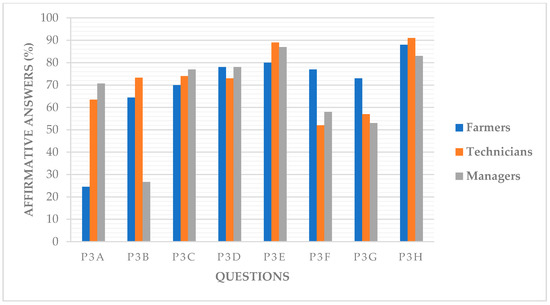
Figure 6.
Answers for questions in Block 2 (all groups).
Third block of questions focused on management and decision-making needs (Table 1). Some questions were addressed only to farmers, others only to technicians and managers, and others to the three groups. Regarding farmers (Figure 7) results (Table 3) showed that: (i) 73.5% of respondents, answered that they are aware of how the cultivated plots behave (P4a); (ii) 73.0% answered to know the plot size (P4c); (iii) 65.3% answered that they know when was the last time that someone asked them for any information about their plots (P4e); and (iv) only 31.9% answered that they know (using real edaphoclimatic data) if there are differences among their distinct plots (P4g).
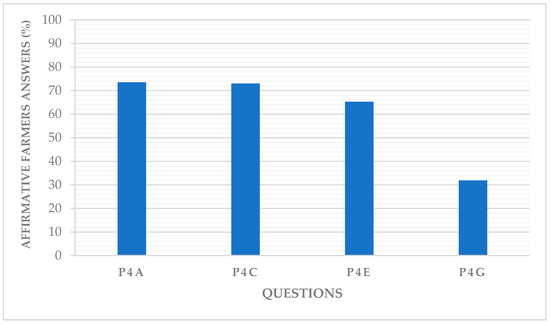
Figure 7.
Farmers answers for questions in Block 3.
Regarding technicians and managers answers (Figure 8): (i) 63.6% of technicians and 93.3% of managers answered that they have to manage data concerning the members of their organization (P4b); (ii) 80.1% of technicians and 93.3% of managers were sure about that they are able to obtain updated information for each of their associates in a reasonable amount of time (P4d); (iii) 93.3% of technicians and 81.8% of managers could tell, based on real data, if there are edaphoclimatic differences among the zones that their organization manages (P4f); and (iv) 66.7% of technicians and 63.6% of managers were able to remember when was the last time that someone asked then for a specific information about one of their associates.
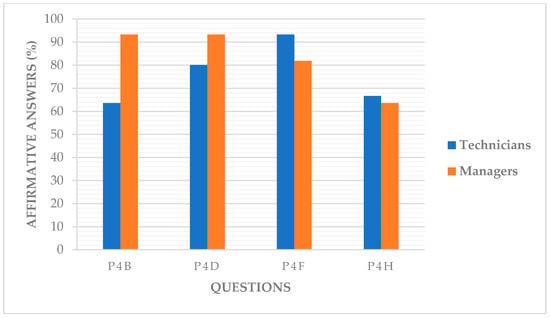
Figure 8.
Answers for questions in Block 3 (technicians and managers).
Finally, answers to questions addressed to all groups (Figure 9) were as following: (i) 84.3% of farmers, 70.7% of technicians, and 80.8% of managers answered that they found difficult to fill in required documentation by current legislation (P4i); (ii) 26.5% of farmers, 73.3% of technicians, and 72.7% of managers deemed that they need information grouped by zones in order to make general decisions (P4j) and statistically significant differences were found between farmers and the two other groups; and (iii) 90.3% of farmers, 86.3% of technicians, and 93.3% of managers considered necessary an accounting system linked to yield data supply (P4k).
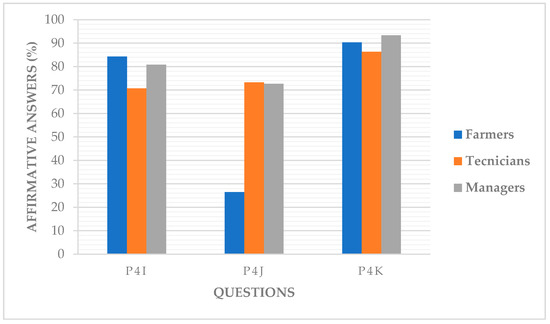
Figure 9.
Common answers for questions in Block 3 (all groups).
The fourth and last block (Figure 10) of questions addressed the use of applications and solutions (Table 1). Regarding farmers (Table 3), 90.2% of them answered that they do not use any type of computer program to manage the information concerning their plots and to assist them in decisions about concerning production (P5a and P5c).
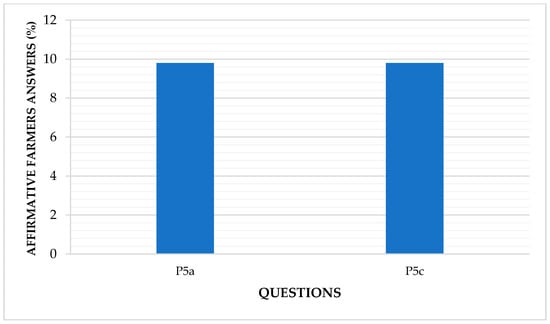
Figure 10.
Answers for questions in Block 4 (farmers).
On the other hand, 70.4% of technicians and 80.3% of managers answered (Figure 11) that they use a computer program to manage the information related to their different associates. Also, 66.7% of technicians and 63.6% of managers affirmed to make decisions at the territorial level (P5b and P5d).
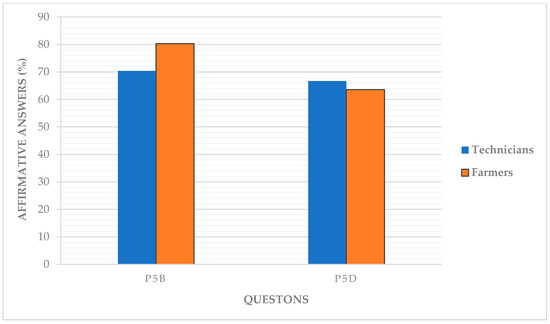
Figure 11.
Answers for questions in Block 4 (technicians and managers).
So, it can be said that there is a need for an ERP platform that coordinates the plot production information at the three decision making levels: farmers, technicians, and managers.
3.2. Functioning of the ERP Platform for an Agricultural Holding
The operation application of the ERP platform designed to manage an agricultural operation in the Autonomous Community of Valencia (Spain) is explained below. The platform was developed and tested under the supervision of the government department of the Autonomous Community that deals with agriculture (Conselleria de Agricultura, Medio Ambiente, Cambio Climático y Desarrollo Rural). Additionally, a group of farmers has also used the application sending continuous feedback that allowed the optimization and improvement of the platform.
3.2.1. Agronomic Management of the Plots
Spanish legislation (Real Decreto 1311/2012) requires farmers to use the Operational Notebook as a record of the daily activity that takes place in an agricultural plot. Thus, this platform permits automatic generation of the documentation required by the regulations, allowing it to be printed or exported to the following telematic formats: PDF, XLS, and CSV. An example of the plots distribution is presented in Figure 12.

Figure 12.
A list of geolocated plots. Personal data has been removed from the image.
First, the plot is geolocated (Figure 13) using WMS technology, and all the information available for the plot is compiled from third-party sources such as the Geographic Information System for Agricultural Parcels (SIGPAC, a tool originally conceived with the purpose of making it easier for farmers to submit applications, with graphic support, as well as to facilitate administrative and on-site controls [50]) or the Catastro (through its cadastral map publication service on the internet [51]). From this moment, all the information added to the plot is automatically geolocated.

Figure 13.
Plot geolocation process.
In order to act as a log of the activities in the plot, the platform was able to manage the agronomic information related to phytosanitary treatments, pests, irrigation, cultivation tasks (pruning, fertilizers, amendments, etc.), incidents that have occurred in the agricultural holding, harvesting, workers and machinery manager, and management of seeds.
The system stores the agronomic actions that are added to it by linking them with a date (date of application or completion), thus their history for each plot can be provided. There is also a list of agronomic actions that can be filtered, listed, and exported according to the needs of the user.
Moreover, the ERP platform allows to provide an evidence of sustainable agricultural practices at the plot level and can set the basis for CO2 uptake. This allows farmers to fulfil CAP and society requirements. Territorial brand managers can also show to society how buying quality food linked to origin contribute to a better environment.
3.2.2. Irrigation Records
The application also permits managing the water inputs to the plots, allowing to keep a historical record of water contributions. Another functionality is to manage all the indicated items required by Spanish legislation, such as bodies of water (Figure 14) and their specific characteristics.
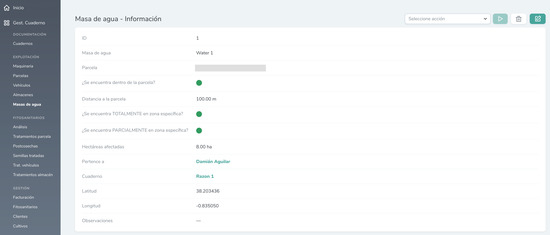
Figure 14.
Bodie of water report. Personal data has been removed from the image.
All this data can be displayed on the screen by means of graphs and related to climatic data, such as rainfall on the plot. This supposes an essential part of the project as water use in agriculture is a major concern in Spain. This provides evidences of farmer environmental concern.
3.2.3. Reports of Climatic Data
The platform allows users to manage their own weather data from an on-site meteorological station, connected to the platform through the connection API. If the user does not have this infrastructure, when geolocating the plot, the system searches for the closest AEMET meteorological station and those the data from will be taken. The user must indicate to the system, through a selector in the administration panel, where the data want to be consulted.
In the case of AEMET, historical data since 2011 from the meteorological stations are available, although for some stations they date back 20 years. Users can access the data records (mainly temperature, humidity, and precipitation) for each day, from the different meteorological stations available in the database. Figure 15 shows an example of data received by the platform from AEMET.

Figure 15.
Example of climatological data from the AEMET climate station, located in Ontinyent (Valencia).
3.2.4. Management System
The platform has a global management system, which allows the administration of roles and permissions which bring access to different parts of the system. The permission system allows different users to access the data based on the parameters established for each of them. The roles and permissions system are managed through the packages developed by Spatie (a software development company), which is called, Laravel permission [40]. This package permits to associate users with roles and permissions. For instance, a farmer can see only their data, while the system administrator can access to all the data. Therefore, a list of system access roles can be established, and each of them with different access permissions. Figure 16 presents users with different accesses and roles on the platform.

Figure 16.
Roles and permission administration. Personal data has been removed from the image.
This opens the possibility to companies technicians to check where the product is processed, and to quality PDO and PGI managers to access information useful in the decision making process from a territorial point of view. Additionally, gives evidence of production good practices regarding CO2 uptake and water use, etc.
3.2.5. Other Components
The platform also has a series of components such as (i) machinery (Figure 17) and vehicle management (inventory management, insurance, maintenance, etc.); (ii) personnel records and management (personal information of workers, training and authorization for the handling of phytosanitary products); (iii) agricultural product commercialization records; (iv) generate reports and documentation and (v) warehouse control.
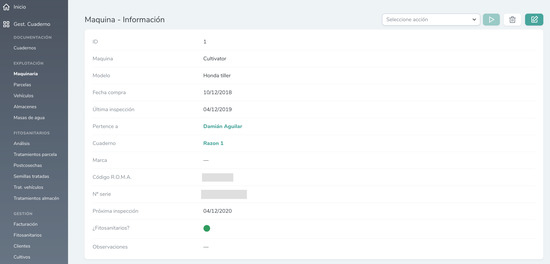
Figure 17.
Machinery management detail. Personal data has been removed from the image.
4. Conclusions
This study revealed that farmers, technicians, and managers of territorial quality brands are aware of the changes needed in the agricultural business model to facilitate a new way of performing the internal management of farms. This must produce an increase in food quality and in environmental concern. Therefore, technological solutions are needed to boost the agricultural sector, which nowadays, as far as it concerned, this is not covered by the technology sector. Thus, the present ERP tool can be the global solution to face both mentioned challenges because allows data collection, information management, its subsequent analysis and finally a detailed traceability of the products and the processes. The importance of this platform refers to the allowance of agricultural information collection in real time, which help to increase the knowledge of the farm and agricultural area situation. This platform, based on the use of Precision Agriculture, is being used by more than 1500 farms that are continuously adding information to the system. At the same time, they are evaluating the product, with the aim of converting all that information into predictive models capable of anticipating the most common problems suffered by agricultural operations, such as pests, droughts, and fertilization. Thus, this is an essential tool which allow farmers to optimize the farm management based on this information. In the future, the platform will be able to process and model the data in real time, offering suggestions and improvements on farms, due to the use of Big Data.
Author Contributions
Conceptualization, D.A.M.; D.B.L.L. and M.C.-L.; Methodology, D.A.M., D.B.L.-L. and F.J.d.C.-G.; Software, D.A.M.; Formal Analysis, D.B.L.-L., L.L. and H.I.-I.; Writing—Original Draft Preparation, D.A.M., D.B.L.-L., L.L. and P.S.-B.; Writing—Review and Editing, D.A.M., L.L. and D.B.L.-L.; Project Administration, D.A.M. and D.B.L.-L. All authors have read and agreed to the published version of the manuscript.
Funding
This research was partly funded by Conselleria de Agricultura, Medio Ambiente, Cambio Climático y Desarrollo Rural (Generalitat Valenciana).
Conflicts of Interest
The authors declare no conflict of interest.
References
- Van Ittersum, K.; Candel, M.J.J.M.; Meulenberg, M.T.G. The influence of the image of a product’s region of origin on product evaluation. J. Bus. Res. 2003, 56, 215–226. [Google Scholar] [CrossRef]
- Ruiz, M.P.M.; Zarco, A.I.J. La potenciación del origen en las estrategias de marketing de productos agroalimentarios. Boletín Económico ICE 2006, 2880, 18. [Google Scholar]
- Felzensztein, C.; Hibbert, S.; Vong, G. Is the Country of Origin the Fifth Element in the Marketing Mix of Imported Wine? J. Food Prod. Mark. 2004, 10, 73–84. [Google Scholar] [CrossRef]
- Kur, A.; Cock, S. Nothing but a GI Thing: Geographical Indications under EU Law. Intellect. Prop. Media Entertain. Law J. 2007, 17, 19. [Google Scholar]
- Simon, Z. UE: Campaña en Tokaj para Acabar con las Imitaciones. Available online: http://elmundovino.elmundo.es/elmundovino/noticia.html?vi_seccion=7&vs_fecha=200406&vs_noticia=1086850889 (accessed on 4 September 2020).
- Skuras, D.; Vakrou, A. Consumers’ willingness to pay for origin labelled wine: A greek case study. Brit. Food J. 2002, 104, 898–912. [Google Scholar] [CrossRef]
- Jones, G.V.; Snead, N.; Nelson, P. Geology and Wine 8. Modeling Viticultural Landscapes: A GIS Analysis of the Terroir Potential in the Umpqua Valley of Oregon. Geosci. Can. 2004, 31, 4. [Google Scholar]
- Caesarius, L.M.; Hohenthal, J. Searching for big data: How incumbents explore a possible adoption of big data technologies. Scand. J. Manag. 2018, 34, 129–140. [Google Scholar] [CrossRef]
- Sakr, S.; Gaber, M.M. Large Scale and Big Data—Processing and Management; Auerbach Publications: Boca Raton, FL, USA, 2014. [Google Scholar]
- Cukier, K.; Mayer-Schönberger, V. Big Data: La Revolución de los Datos Masivos, 1st ed.; Turner Publicaciones S.L.: Madrid, Spain, 2013; ISBN 978-84-15427-81-0. [Google Scholar]
- Aguilar, L.J. Big Data, Análisis de Grandes Volúmenes de Datos en Organizaciones; Alfaomega Grupo Editor: Mexico City, Mexico, 2016; ISBN 978-607-707-757-2. [Google Scholar]
- Bhat, W.A. Bridging data-capacity gap in big data storage. Future Gener. Comput. Syst. 2018, 87, 538–548. [Google Scholar] [CrossRef]
- De, B. API Management: An Architect’s Guide to Developing and Managing APIs for Your Organization; Apress: New York, NY, USA, 2017; ISBN 978-1-4842-1305-6. [Google Scholar]
- Nguyen, V.-Q.; Nguyen, S.N.; Kim, K. Design of a Platform for Collecting and Analyzing Agricultural Big Data. J. Digit. Contents Soc. 2017, 18, 149–158. [Google Scholar] [CrossRef]
- Corbellini, A.; Mateos, C.; Zunino, A.; Godoy, D.; Schiaffino, S. Persisting big-data: The NoSQL landscape. Inf. Syst. 2017, 63, 1–23. [Google Scholar] [CrossRef]
- Bicevska, Z.; Oditis, I. Towards NoSQL-based Data Warehouse Solutions. Procedia Comput. Sci. 2017, 104, 104–111. [Google Scholar] [CrossRef]
- Liao, Y.-T.; Zhou, J.; Lu, C.-H.; Chen, S.-C.; Hsu, C.-H.; Chen, W.; Jiang, M.-F.; Chung, Y.-C. Data adapter for querying and transformation between SQL and NoSQL database. Future Gener. Comput. Syst. 2016, 65, 111–121. [Google Scholar] [CrossRef]
- Bongiovani, R.; Chartuni, E.; Best, S.; Roel, Á. Agricultura de Precisión: Integrando Conocimientos para una Agricultura Moderna y Sustentable; Procisur/IICA: San José, Costa Rica, 2006; ISBN 978-92-9039-741-0. [Google Scholar]
- Pucha-Cofrep, F.; Fries, A.; Cánovas-García, F.; Oñate-Valdivieso, F.; González-Jaramillo, V.; Pucha-Cofrep, D. Fundamentos de SIG: Aplicaciones con ArcGIS; Ediloja Cia. Ltda.: Loja, Ecuador, 2017; ISBN 978-9942-28-901-8. [Google Scholar]
- Carbonell, I.M. The ethics of big data in big agriculture. Internet Policy Rev. 2016, 5. [Google Scholar] [CrossRef]
- Roblek, V.; Meško, M.; Krapež, A. A Complex View of Industry 4.0. SAGE Open 2016, 6. [Google Scholar] [CrossRef]
- Weltzien, C. Digital agriculture—Or why agriculture 4.0 still offers only modest returns. Agric. Eng. 2016, 71, 66–68. [Google Scholar]
- Braun, A.-T.; Colangelo, E.; Steckel, T. Farming in the Era of Industrie 4.0. Procedia Cirp 2018, 72, 979–984. [Google Scholar] [CrossRef]
- Lee, J.; Lapira, E.; Bagheri, B.; Kao, H. Recent advances and trends in predictive manufacturing systems in big data environment. Manuf. Lett. 2013, 1, 38–41. [Google Scholar] [CrossRef]
- Latorre, M. Historia de las Web, 1.0, 2.0, 3.0 y 4.0. Available online: http://umch.edu.pe/arch/hnomarino/74_Historia%20de%20la%20Web.pdf (accessed on 7 August 2020).
- Surjit, R.; Rathinamoorthy, R.; Vardhini, K.J.V. ERP for Textiles and Apparel Industry; CRC Press: Boca Ratón, FL, USA, 2016; ISBN 978-93-85059-59-9. [Google Scholar]
- Elragal, A.; Haddara, M. The Future of ERP Systems: Look backward before moving forward. Procedia Technol. 2012, 5, 21–30. [Google Scholar] [CrossRef]
- Stauffer, M. Laravel: Up and Running: A Framework for Building Modern PHP Apps; O’Reilly Media, Inc.: Sebastopol, CA, USA, 2016. [Google Scholar]
- Hasan, S.S.; Isaac, R.K. An integrated approach of MAS-CommonKADS, Model–View–Controller and web application optimization strategies for web-based expert system development. Expert Syst. Appl. 2011, 38, 417–428. [Google Scholar] [CrossRef]
- Chen, X.; Ji, Z.; Fan, Y.; Zhan, Y. Restful API Architecture Based on Laravel Framework. J. Phys. Conf. Ser. 2017, 910, 012016. [Google Scholar] [CrossRef]
- Anh, N.V. Anhskohbo/no-captcha. Available online: https://github.com/anhskohbo/no-captcha (accessed on 10 August 2020).
- Askedio/laravel-soft-cascade: Cascade Delete & Restore When Using Laravel SoftDeletes. Available online: https://github.com/Askedio/laravel-soft-cascade (accessed on 10 August 2020).
- Heuvel, B. vd barryvdh/laravel-dompdf: A DOMPDF Wrapper for Laravel. Available online: https://github.com/barryvdh/laravel-dompdf (accessed on 10 August 2020).
- Bronner, M. GeneaLabs/laravel-model-caching: Eloquent Model-Caching Made Easy. Available online: https://github.com/GeneaLabs/laravel-model-caching (accessed on 10 August 2020).
- Intervention Image—Introduction. Available online: http://image.intervention.io/ (accessed on 10 August 2020).
- Estefane, J. Grimzy/laravel-mysql-spatial: MySQL Spatial Data Extension Integration with Laravel. Available online: https://github.com/grimzy/laravel-mysql-spatial (accessed on 10 August 2020).
- Brouwers, P. Maatwebsite/Laravel-Excel: Supercharged Excel Exports and Imports in Laravel. Available online: https://github.com/Maatwebsite/Laravel-Excel (accessed on 10 August 2020).
- Spatie/laravel-cookie-consent: Make Your Laravel App Comply with the Crazy EU Cookie Law. Available online: https://github.com/spatie/laravel-cookie-consent (accessed on 10 August 2020).
- Spatie/laravel-html: Painless Html Generation. Available online: https://github.com/spatie/laravel-html (accessed on 10 August 2020).
- Spatie/laravel-permission: Associate Users with Roles and Permissions. Available online: https://github.com/spatie/laravel-permission (accessed on 10 August 2020).
- Laravel Nova. Available online: https://nova.laravel.com/ (accessed on 11 August 2020).
- Forta, B. MariaDB Crash Course; Addison-Wesley Professional: Boston, MA, USA, 2011; ISBN 978-0-13-284235-8. [Google Scholar]
- Chodorow, K. MongoDB: The Definitive Guide: Powerful and Scalable Data Storage; O’Reilly Media, Inc.: Sebastopol, CA, USA, 2013; ISBN 978-1-4493-4482-5. [Google Scholar]
- Sarig, M. MongoDB vs. MySQL: The Differences Explained. Available online: https://blog.panoply.io/mongodb-and-mysql (accessed on 10 August 2020).
- Object-Relational Mapping. Available online: https://en.wikipedia.org/w/index.php?title=Object-relational_mapping&oldid=952535425 (accessed on 10 August 2020).
- Bean, M. Laravel 5 Essentials; Packt Publishing Ltd.: Birmingham, UK, 2015; ISBN 978-1-78528-329-1. [Google Scholar]
- Xu, C.; Sun, X.; Li, B.; Lu, X.; Guo, H. MULAPI: Improving API method recommendation with API usage location. J. Syst. Softw. 2018, 142, 195–205. [Google Scholar] [CrossRef]
- Sturm, R.; Pollard, C.; Craig, J. Chapter 11—Application Programming Interfaces and Connected Systems. In Application Performance Management (APM) in the Digital Enterprise; Sturm, R., Pollard, C., Craig, J., Eds.; Morgan Kaufmann: Boston, MA, USA, 2017; pp. 137–150. [Google Scholar]
- Helmke, M. Ubuntu Unleashed 2015 Edition: Covering 14.10 and 15.04; Sams Publishing: Carmel, IN, USA, 2014. [Google Scholar]
- Sistema de Información Geográfica de Parcelas Agrícolas (SIGPAC). Available online: https://www.mapa.gob.es/es/agricultura/temas/sistema-de-informacion-geografica-de-parcelas-agricolas-sigpac-/default.aspx (accessed on 10 August 2020).
- Portal de la Dirección General del Catastro. Available online: http://www.catastro.minhap.gob.es/esp/wms.asp (accessed on 10 August 2020).
© 2020 by the authors. Licensee MDPI, Basel, Switzerland. This article is an open access article distributed under the terms and conditions of the Creative Commons Attribution (CC BY) license (http://creativecommons.org/licenses/by/4.0/).